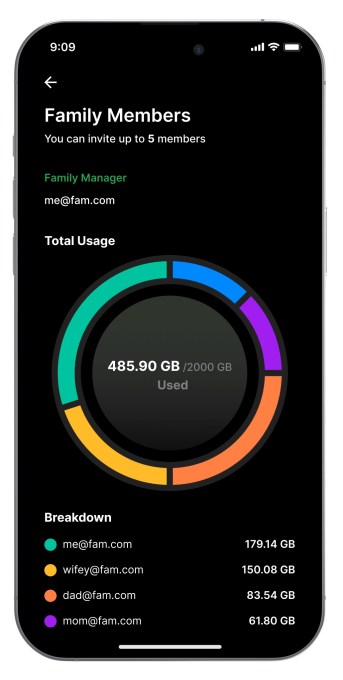

OpenSNP, a large open source repository for user-uploaded genetic data, will shut down and delete all of its data at the end of April, co-founder Bastian Greshake Tzovaras has confirmed.
In a blog post, openSNP’s Greshake Tzovaras attributed the decision to shutter the site due to concerns of data privacy following the financial collapse of 23andMe and the rise in authoritarian governments around the world.
Founded in 2011 by Greshake Tzovaras, along with Philipp Bayer and Helge Rausch, openSNP became an open and public repository for customers of commercial genetic testing kits, including 23andMe, to upload their test results and find others with similar genetic variations. The site had close to 13,000 users at the time of its closure announcement, making it one of the largest public repositories of genetic data. Since its founding, openSNP has touted its contributions to academic and scientific research, and identified more than 7,500 genomes.
News of openSNP’s shutdown comes in the wake of 23andMe filing for bankruptcy protection, intensifying concerns that the company’s vast banks of customers’ sensitive genetic data will be sold to the highest bidder, who may not adhere to 23andMe’s privacy commitments. The attorneys general for the states of California and New York, among others, have warned 23andMe customers to delete their data ahead of the court-approved selloff later this year.
Greshake Tzovaras also said a contributing factor in shutting down openSNP was the “rise in far-right and other authoritarian governments,” citing the removal of public data from the U.S. government’s websites soon after President Trump returned to power.
“The risk/benefit calculus of providing free and open access to individual genetic data in 2025 is very different compared to 14 years ago,” wrote Greshake Tzovaras. “Sunsetting openSNP — along with deleting the data stored within it — feels like it is the most responsible act of stewardship for these data today.”
When reached by TechCrunch, Greshake Tzovaras was blunt in his decision to shut down openSNP now and not sooner.
“The ‘why now’ to me is ultimately down to there being what counts for a fascist coup in the U.S.,” Greshake Tzovaras told TechCrunch, a native of Germany.
“Seeing people being disappeared from the streets under the most dubious pretexts really can’t be called anything else,” he said, referring to the recent reports of people living in the United States, including U.S. citizens, who have been arrested in immigration raids, some whose whereabouts remain unknown.
Greshake Tzovaras said the “wholesale dismantling of scientific institutions and science itself” since January — the beginning of the second Trump administration — was a factor in the shutdown of openSNP.
“I don’t think it’s a stretch to worry about how genetic data might be soon abused to make false claims about a variety of topics, effectively bringing back a darker eugenics age,” he said.
Greshake Tzovaras said openSNP has “always been a balancing act” between its potential uses and risks, and that the site’s existence has been an “ongoing thought of whether the benefits can outweigh the risks.”
In one historical example he gave — when law enforcement used genetic data from genealogy site GEDmatch in 2018 to identify a notorious serial killer — Greshake Tzovaras said openSNP seemed at the time like it was less relevant or at risk for use by law enforcement compared to larger ancestry-specific databases. (Greshake Tzovaras confirmed to TechCrunch that notwithstanding the open and public nature of the data it stores, openSNP has never received a law enforcement request for any genetic or user data.)
Greshake Tzovaras said that compared to the first Trump administration, “the misuse of science was both qualitatively and quantitatively very different than what we see today.”
“Alongside the larger conversation about the impact of genetic data in the context of 23andMe’s bankruptcy, we decided that it’s time to pull the plug,” Greshake Tzovaras told TechCrunch.
Greshake Tzovaras also told TechCrunch that on a positive reflection, keeping openSNP running for 14 years may be his “biggest achievement.” He said openSNP ran on about $100 per month, in the face of commercial startups that have worked to monetize people’s data yet ultimately failed. Greshake Tzovaras said that in that sense, openSNP “feels like a testament to the power of open source/culture.”
The site has also contributed to research and publications “across a wide range of disciplines — from infosec/privacy all the way to biomedical studies,” said Greshake Tzovaras. Many undergraduates also benefited from having access to real-world data hosted by openSNP, he said.
“In that sense, I think our hope of ‘democratizing’ access to genomics was at least partially successful,” said Greshake Tzovaras.
Updated to amend the name of openSNP’s name throughout.
Keep reading the article on Tech Crunch
Despite Google’s intentions for its default image viewing and editing app for Android, the Photos app has, over the years, become one of the most popular photo backup services around. In fact, it was one of the most attractive offerings for years until it stopped offering unlimited storage in 2020.
That change in the tech giant’s strategy has left some space for other photo backup services to grow and showcase their offerings to people. Especially for people who don’t want to hand over pictures of their entire life to big tech companies, photo backup services that focus on privacy have become really attractive. That’s where Ente comes in.
An open-source project by Vishnu Mohandas, a former Google employee, Ente (which means “Mine” in Malayalam) offers end-to-end encrypted photo storage across various platforms — meaning the service cannot access its users’ photos at all. The startup says it stores photos at three different locations for better reliability and access, and the open-source nature of the project means anyone can inspect the code or even spin up their own server to store their pictures securely.
The company says all its user-facing features are processed on-device — the processing for features like identifying faces and locations, creating themes and curating memories is done locally — and the processed information is synced with other devices using end-to-end encryption. You can also use natural language to search for photos, such as “beach sunsets in India.”
The service offers a web client as well as Android, iOS and desktop apps, and comes with 10GB of free storage. Users can pay for plans starting from $9.99 per month for 1TB of storage, and can share one account with five people.

In an interview with TechCrunch, Mohandas said that while he uses a lot of Google products, including Photos, the company’s privacy practices made him uncomfortable.
“Google takes security seriously, but not user privacy. They don’t really care about customer data or what implications can come from being careless about it. In hindsight, this is not surprising because they are an advertisement company,” Mohandas said. He eventually tried out Apple and Dropbox but wasn’t satisfied with their interfaces or how difficult it was to access pictures across different platforms and devices.

Ente, which is bootstrapped, claims it has over 150,000 registered customers who have collectively stored over 165 million photos on the app. Despite the traction, Mohandas says the company doesn’t yet have any ambitions to seek out venture capital.
“The cost of a company like us shutting down is really high, as all our customers would need to take off their data. We don’t want to take venture money at the moment and try and get growth in a manner that could lead us to shut down,” Mohandas said.
He said the open-source community around Ente is strong, and all its 12 employees were previously part of the community. The company also offers dedicated support for folks who want to self-host the app.
Mohandas realizes that privacy features aren’t going to be enough to sell a service like this and says that’s why Ente has tried to maintain feature parity with services like Google Photos. The startup is also considering releasing an Android app that doesn’t require users to log in and offers photo categorization features locally.
Keep reading the article on Tech Crunch

Seattle-based Temporal has made its name over the last several years in the world of microservices — specifically providing a platform to orchestrate the messy business of building and operating integrations and updates across disparate services and apps in the cloud. But the AI boom has come at the company fast. Now, Temporal has raised a growth round of $146 million to build what it believes the next chapter will be in its space: AI, and specifically building microservices to support newer areas like agentic AI.
A chunk of the investment will be going into R&D. At the end of 2024, the company launched a new feature called Nexus in its Temporal Cloud platform to improve security, fault isolation and modularity, and it says it’s going to continue developing that, alongside public cloud availability for Azure, enabling more cross-cloud work, and “R&D for AI use cases.” Temporal will also be using some of the funds to invest in sales and marketing.
Tiger Global is leading the round, with participation from previous backers that include Index Ventures (who led the Series B) and Sequoia Capital (who led the Series A ). With this Series C, Temporal has now raised $350 million.
The round is sizeable, but the devil is in the details. TechCrunch understands that the company’s valuation with this round is $1.72 billion post-money — “a little bit up — a very little bit,” in the words of CEO and co-founder Samar Abbas said.
The company’s previous funding — a $75 million Series B extension announced February 2023 — was made at a flat valuation of $1.5 billion. And ahead of that, there was a report in Prime Unicorn Index that the valuation had dipped as low as $880 million, a figure the company has not confirmed.
Abbas and his co-founder Maxim Fateev (CTO) started Temporal after the pair worked together at Uber, where they jointly developed Cadence, Uber’s open source orchestration engine designed to route requests and mediate interactions between different microservices.
Knowing that the need for better microservices management extended to many organizations, the pair saw an opportunity to strike out on their own, and Temporal was born.
Temporal’s microservices orchestration platform predates the hype around AI. Customers have been using it since 2019 to help manage functions and actions that bring together data from numerous, disparate apps — payment processing, customer onboarding, order management, ID verification, and infrastructure management among them.
More recently, though, services built on AI, and specifically to fill out the promise of agentic AI — which bring together language models to work with and across data from a number of other services in AI ‘agents’ tailored for specific use cases — have emerged as a prime use case for microservices.
The company’s current client list speaks not only to which companies are using Temporal’s platform to manage any microservice, legacy or otherwise, but also which ones are already using it for AI specifically. The list includes Box, Instacart, Snap and Stripe, as well as Nvidia.
Nvidia is a notable name in that big-name list. A year ago, the GPU giant announced a microservices software platform called NIM to streamline the deployment of AI models (both custom and pre-trained) in production environments. One of the latest developments in that microservices platform has included helping its customers develop AI agents to address trust and safety.
Temporal is still growing, albeit not at the pace it used to in the past. The company told TechCrunch that revenues are up 4.4x in the past 18 months; that’s compared to more than 20x growth the company claimed in the 12 months to Feburary 2023. Meanwhile, the company says that its Temporal.io open source platform now has 183,000 active users; and its enterprise managed service Temporal Cloud now claims 2,500 customers.
There’s no debate that “durable execution,” the category that Abbas and Fateev pioneered, is less buzzy than Ghibli-style AI image generators. But the need to execute long workflows reliably is real, and other teams have entered the field since then, such as workflows-as-code startup Restate and Orkes.
Abbas has been Temporal’s CEO since he and Fateev swapped their roles in April of last year. With “zero reports,” Fateev is now in charge of technology and setting the long term vision. “I am the one who is figuring out what steps we need to take to deliver on that mission,” Abbas said.
These steps include growing headcount from some 250 employees to over 300 in the coming months, as well as “doing a big push in EMEA and [Asia-Pacific & Japan],” he said.
Keep reading the article on Tech Crunch